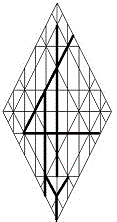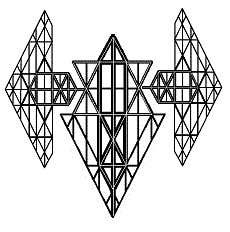Let there Be!
A nexus was needed between the thought’s conception and its implementation: a shift from the theoretical to the practical. Within timeless eternity, therefore, the creation 36 found its beginning in the emanation of the logos, which was the articulation of HaShem’s word, the body of his thought.
When the process of creation began, therefore, it was understood that the fullness of God’s vision would be known in the ripened appearance of its effects, the time of harvest. When that moment comes, all that live will manifest divine sentience, within and among themselves; for having been nurtured, all will grow into a most intimate knowledge of hla.
When proclamation of the word began, creation embarked on a timed journey to the end of days. From the beginning, therefore, wheels began to turn within wheels.
Of that first day it is written that creation, which is the expression of HaShem’s will, was tohu and bohu— that is to say that the temporal realm, taking form in response to the father’s song, was formless and empty, and that HaShem perceived great darkness on the face of potentiality; for all that would come to pass, one day, was yet veiled in darkness.
 God’s
spirit was moved by the fluidity of that which might be; and as the
first morning approached, the word was released, “Let there be—
lightening rwa!” And emanating from
the eternal at the command of his word’s enunciation, God’s formless
spirit found release from Ein Sof and undertook expression in the
temporal.
God’s
spirit was moved by the fluidity of that which might be; and as the
first morning approached, the word was released, “Let there be—
lightening rwa!” And emanating from
the eternal at the command of his word’s enunciation, God’s formless
spirit found release from Ein Sof and undertook expression in the
temporal. No longer the offspring of amorphous concepts, the vision had taken on a life of its own. HaShem’s thoughts had pierced the firmament of the temporal with the logic a and the language l of his projected word hwla.
The word of HaShem entered the temporal, driven by the father’s spirit, and the vision began to clarify in accordance with the pattern ingrained within the divine seed of thought; for the blueprint of creation was begotten in congruence with the mind of HaShem, coming to birth by expression.
The principles within HaShem’s spirit were made evident as the Light h of God hla appeared, falling upon the bowls of sentience and filling them with the seeded concepts that had first appeared within God’s vision. Once begun, the mandate of the living word of hwla would never end.
Through embodiment of the word— that is, by the enunciation of divine thought, by its projection into temporal realms— all things were made; and without the expressed word of the Life Force, nothing was made that has been made.
The father invested his Breath of Life in the temporal by its projection; and the expression of that life, cycle upon cycle, is becoming the light rwa of men. It shines in the darkness of our bodies, and the darkness does not overcome it.
Our father a bears the weight w of his authority r. His great power a thunders w within his mind r. He ponders and plans a with merciful w mastery r; for his fiery principles a must lay claim to their seat within the lamps w of anointed minds r. HaShem’s passion is to cultivate a true w knowledge r.
Gematria 207 zr: Knowledge that is perfect z
Ordinal 27 zk: displays the fruit k of its perfection z.
Checksum: A completely thorough measurement f (9 f) of all evidence k results z (27 zk) in knowledge r that is perfectly objective z (207 zr). And because it has been both tested k and
verified z (27 zk), it will have reached conclusions that resolve all outstanding issues f (9 f).
 The
presence of HaShem saturates the eternal realm. To expand, therefore,
the Infinite One had to become, also, less: to become greater, our la
had to become, also, smaller. For immortality to become a meaningful
concept, mortality would have to be established and, subsequently,
overcome.
The
presence of HaShem saturates the eternal realm. To expand, therefore,
the Infinite One had to become, also, less: to become greater, our la
had to become, also, smaller. For immortality to become a meaningful
concept, mortality would have to be established and, subsequently,
overcome. It was the pleasure of the great spirit that his word should dwell in thick darkness. A servant of growth, he chose to project the light of day upon the darkness that had entombed his seed. Darkness cannot withstand light but flees before it; and so, the scripture reads, “there was evening and there was morning, day one.”
The fading evening that comes before and follows after the expanse of night would usher in each new morning; for the second day would see creation of the expanse in which night and day dance. That dance had already begun, however, with the Light Bearer’s pressing words, “Let there be….”